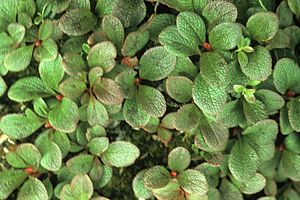Red fruit bearberry facts for kids
Quick facts for kids Red fruit bearberry |
|
|---|---|
 |
|
| Conservation status | |
| Scientific classification | |
| Synonyms | |
|
A. alpina rubra |
The Red Fruit Bearberry (Arctostaphylos rubra) is a type of flowering plant. It belongs to the heath family, which includes plants like blueberries and cranberries. This plant is also part of a group called Arctostaphylos, known as manzanitas and bearberries.
People call it by many names, such as alpine bearberry, arctic bearberry, red manzanita, and ravenberry. You can find this plant naturally across a huge area. It grows in parts of Eurasia and northern North America, from Alaska all the way through most of Canada to Greenland. There's even a small group of these plants in the Absaroka Mountains of Wyoming, which is in the main part of the United States.
Contents
What Does the Red Fruit Bearberry Look Like?
This plant is a small, spreading shrub. It usually grows only up to about 15 centimeters (6 inches) tall. Its leaves are between 2 and 6 centimeters (1 to 2.5 inches) long. They are also marcescent, which means they stay on the plant even after they die.
The plant produces flowers in a cluster called a raceme. This cluster can have up to 6 flowers, and each flower is about half a centimeter long. The flowers are covered in fine hairs and tiny glands. After the flowers, the plant grows a type of fruit called a drupe. This is a fleshy fruit with a hard pit inside, like a cherry or a peach.
How the Red Fruit Bearberry Grows and Spreads
The Red Fruit Bearberry can make new plants in a couple of ways. It can grow from seeds, which are found inside its fruits. It can also spread by sending out special stems called stolons and underground stems called rhizomes. These stems can grow roots and shoots, forming new plants nearby.
Where Does the Red Fruit Bearberry Live?
This shrub is a common part of many plant groups in very cold places. You can find it in Arctic and alpine climates, which are cold, high-altitude areas. It often grows in subalpine forests and open, treeless lands called tundra.
It's a common plant in forests where spruce trees are the main type of tree. These include white spruce and black spruce forests. The Red Fruit Bearberry can even be the most common plant in some areas. For example, it grows a lot in balsam poplar floodplains and tundra shrublands in Alaska.
It's also a main plant, or shares the top spot, with Engelmann spruce and cup lichen in Jasper National Park in Canada. You can find it with white spruce and mountain alder near the Mackenzie Delta. It also grows with white spruce along the Alaska Highway in Yukon. In warmer areas, this plant grows at higher elevations, especially near the timberline, which is the edge where trees stop growing. Scientists think that because of climate change, this plant is now growing in even higher and more northern places than before.
What Kind of Soil Does It Like?
This shrub likes to grow in soils that don't have many nutrients. It prefers cold regions, often where the soil is frozen all year round, a condition called permafrost. It's most common in wet places, like the edges of lakes and bays, along riverbanks, in bogs, and on wet forest floors.
The Red Fruit Bearberry is often one of the first plants to grow in new or disturbed areas. This is called a pioneer species. It can start growing in places where all other plants have been removed. This includes floodplains, bare tundra, cleared spots in taiga (boreal forests), and newly formed dunes. You might see it growing along the scraped edges of melting glaciers or in old tracks left by bulldozers. Events like floods, oil spills, and wildfires can actually help this plant spread and become more common.
Who Eats the Red Fruit Bearberry?
Many animals enjoy eating the fruits of the Red Fruit Bearberry. This includes large mammals like polar bears and other types of bears. Smaller animals like meadow voles, red-backed voles, and western heather voles also munch on them. Even Dall's sheep, caribou, and hoary marmots sometimes eat them. Birds, such as Ravens, also feed on these berries.
This plant is also good for helping to regrow plants in wet, disturbed areas. It's often used in efforts to bring back vegetation in subalpine and boreal regions, which are cold, northern forest areas.
How People Use the Red Fruit Bearberry
The fruits of the Red Fruit Bearberry are safe for humans to eat. However, they are not usually a favorite food because they might not taste as sweet or flavorful as other berries. Despite this, the fruits have been used by some Indigenous peoples, including the Gwich'in people and the Inuit, for food or other purposes.


